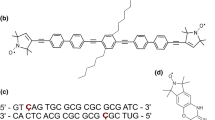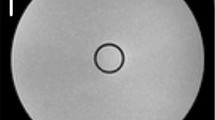Abstract
A rescaling procedure is proposed for electron spin echo envelope modulation spectra observed at several electron paramagnetic resonance transitions. Analytical expressions describing the relations between the rescaled frequencies and hyperfine and quadrupole parameters of the remote nucleus are obtained. The dependences of the rescaled data on the external magnetic field and spin projections of the ion nucleus and the remote nuclei are used to derive the parameters of the nuclear state in the crystals Y2SiO5 and YVO4 doped by ion Nd3+.








Similar content being viewed by others
References
L.G. Rowan, E.L. Hahn, W.B. Mims, Phys. Rev. 137(1A), A61–A71 (1965)
G.M. Zhidomirov, K.M. Salikhov, Theor. Exp. Chem. 4(4), 332–334 (1971). https://doi.org/10.1007/bf00524127
A. Schweiger, G. Jeschke, Principles of Pulse Electron Paramagnetic Resonance (Oxford University Press, Oxford, 2001)
J. McCracken, in Encyclopedia of Inorganic Chemistry, ed. by R.H. Crabtree (Wiley, Chichester, 2008)
S.A. Dzuba, D. Marsh, in Electron Paramagnetic Resonance, vol. 24, ed. by B.C. Gilbert, V. Chechik, D.M. Murphy (Royal Soc Chemistry, Cambridge, 2015), pp. 102–121
S.A. Dikanov, Y.D. Tsvetkov, Electron Spin Echo Envelope Modulation Spectroscopy (CRC Press, Boca Raton, 1992)
P. Höfer, A. Grupp, H. Nebenführ, M. Mehring, Chem. Phys. Lett. 132(3), 279–282 (1986)
G. Jeschke, R. Rakhmatullin, A. Schweiger, J. Magn. Reson. 131(2), 261–271 (1998)
A.G. Maryasov, M.K. Bowman, J. Phys. Chem. B 108(27), 9412–9420 (2004)
C. Gemperle, G. Aebli, A. Schweiger, R.R. Ernst, J. Magn. Reson. 88(2), 241–256 (1990)
S.A. Dikanov, A.P. Spoyalov, J. Hüttermann, J. Chem. Phys. 100(11), 7973–7983 (1994)
S.A. Dikanov, A.M. Tyryshkin, I. Felli, E.J. Reijerse, J. Huttermann, J. Magn. Reson. 108, 99–102 (1995)
A.M. Raitsimring, P. Borbat, T.K. Shokhireva, F.A. Walker, J. Phys. Chem. 100(13), 5235–5244 (1996)
S.C. Larsen, D.J. Singel, J. Phys. Chem. 96(26), 10594–10597 (1992). https://doi.org/10.1021/j100205a005
G.J. Gerfen, P.M. Hanna, N.D. Chasteen, D.J. Singel, J. Am. Chem. Soc. 113(25), 9513–9519 (1991). https://doi.org/10.1021/ja00025a015
G.J. Gerfen, D.J. Singel, J. Chem. Phys. 93(7), 4571–4580 (1990)
R. Eremina, T. Gavrilova, I. Yatsyk, I. Fazlizhanov, R. Likerov, V. Shustov, Y. Zavartsev, A. Zagumennyi, S. Kutovoi, J. Magn. Magn. Mater. 440, 13–14 (2017)
F. Ermeneux, C. Goutaudier, R. Moncorge, M. Cohen-Adad, M. Bettinelli, E. Cavalli, Opt. Mater. 8(1–2), 83–90 (1997)
A. Abragam, B. Bleaney, Electron Paramagnetic Resonance of Transition Ions (Oxford University Press, Oxford, 2012)
A.G. Maryasov, M.K. Bowman, J. Magn. Reson. 221, 69–75 (2012)
G. Wolfowicz, H. Maier-Flaig, R. Marino, A. Ferrier, H. Vezin, J.J.L. Morton, P. Goldner, Phys. Rev. Lett. 114(17), 170503 (2015)
O. Guillot-Noël, V. Mehta, B. Viana, D. Gourier, M. Boukhris, S. Jandl, Phys. Rev. B 61(22), 15338 (2000)
Y. Deligiannakis, M. Louloudi, N. Hadjiliadis, Coord. Chem. Rev. 204(1), 1–112 (2000)
M.J. Duer, ed., Solid State NMR Spectroscopy. Principles and Applications (Blackwell Science, Oxford, 2002)
Acknowledgements
This work was done within the framework of fundamental research AAAA-A18-118030690040-8 of FRC Kazan Scientific Center of RAS. The doped Y2SiO5 and YVO4 crystals have been grown and the ESEEM experiment on the Y2SiO5 crystal has been performed with support of the Russian Science Foundation (project 16-12-00041). We wish to express our appreciation to Prof. Art van der Est for the appropriate comments and for the proposed corrections.
Author information
Authors and Affiliations
Corresponding author
Appendix: Eigenvalues of the Nuclear Spin States
Appendix: Eigenvalues of the Nuclear Spin States
The Eigenfunctions of the spin-Hamiltonian (Eq. 1) in the limiting cases given by approximations (Eqs. 2, 3) can be factorized to the product of the wavefunctions that describe independently the evolution of the spin states of the sublevels of the individual nuclei. This property allows the energy levels of the nuclear sublevels to be derived by solving the eigenvalue problem of the truncated Hamiltonian as shown below.
In the following, it is convenient to describe the transformation operations on a matrix \({\mathbf{m}}\) based on its row-vectors \({\mathbf{m}}_{\chi = x,y,z}\):
We also introduce the rotation matrix, u(r), that aligns an arbitrary vector \({\mathbf{r}} = \left\{ {x,y,z} \right\}\) with the coordinates x, y and z along the z-axis of a new coordinate system:
The curly braces are used here and below for the notation of the vector via its components. The matrix u(r) can be determined from the relation (Eq. A2) as a scalar product of two rotation matrices:
According to the definitions (Eqs. A1, A2), the transformation matrix to the frame where the electron spin is aligned along the quantization axis of the Zeeman interaction equals:
By definition, the Zeeman spin-Hamiltonian in this basis is
where
is the Larmor frequency of the electron spin and geff is the effective value of the g-tensor.
In the following, we will choose the z-direction as the quantization axis and use the same notation for the axes in different coordinate systems. The tensors will be identified by additional superscript symbols referring to the particular coordinate system. The tensor of the HFI in the basis (Eq. A4) becomes:
The relations (2) allow the non-secular terms of the HFI to be neglected for all nuclear spins except the nucleus of the ion (n = 0). The evolution of the electron spin under these conditions becomes independent on the states of the nearby nuclei (\(n \ne 0\)). Assuming that the hyperfine sublevels of the ion are well resolved, the microwave excitation mixes rather weakly the nuclear sublevels of the spin \(I_{0}\). Thus, several EPR transitions can be detected due to the HFI of the nucleus n = 0 and the ESEEM data can be detected at several resonance fields. It is important to note here that, although the HFI of the ion nucleus does not manifest itself directly in the ESEEM spectra, it can indirectly affect on the modulation frequencies via a change of the quantization axis of the electron spin. Therefore, the wavefunctions of the electron spin have to be evaluated carefully in this case.
The nuclear Zeeman and quadrupole interactions of the ion typically are much weaker than the HFI and do not influence the electron spin state. Thus, the evolution of the electron and nuclear spins of the ion can be described by the truncated spin-Hamiltonian:
Note, that the electron spin here is quantized along the direction determined by the Zeeman interaction while the nuclear spin is defined along the z-axis of the laboratory frame.
The precession of the nuclear spin is determined by the HFI-induced local field which in general is not collinear to the quantization axis of the electron spin. According to definitions (Eqs. A1–A3), the nuclear spin quantization axis is determined by the rotation matrix:
The rotation of the nuclear states by the matrix (Eq. A9) gives the following form of the spin-Hamiltonian (Eq. A8):
where
The matrix elements of the Hamiltonian (Eq. A10) can be presented in block-matrix form where each submatrix describes the nuclear spin subsystem for the particular state of the electron spin:
Here the operator I0 represents the identity matrix operator of the nuclear spin n = 0. According to the relations Eq. (2), the main contribution to the diagonal block matrices (Eq. A12) comes from the electron spin Zeeman interaction. In other words, the states between the upper and lower blocks are separated approximately by the Zeeman energy. The contributions of the off-diagonal blocks to the eigenfunctions of the Hamiltonian (Eq. A12) do not exceed \(\left\| {j_{0} {\mathbf{A}}_{0, - }^{*} } \right\|/\left( {\omega_{e} - j_{0} A_{0,zz}^{*} } \right)\), where \(j_{n = 0}\) is the value of the nuclear spin n = 0. Thus perturbation theory can be applied to derive the eigenstates of the spin-Hamiltonian (Eq. A12). First-order perturbation treatment gives the following expressions for the eigenstates of spin-Hamiltonian (Eq. A10):
The Greek letters α = +1/2 and β = − 1/2 here refer to the electron spin projections along the Zeeman interaction, k and l are the magnetic quantum numbers of the nuclear spin, and \(E_{k}^{ \pm }\) are the zeroth-order eigenvalues the of the Hamiltonian \(H_{\text{e}}\):
The operators \({\mathbf{A}}_{0, \pm } {\mathbf{I}}_{0}\) in Eq. (A13) are the sums of the Cartesian operators that change the nuclear spin projection by the values \(\Delta k = 0, \pm 1\) only. Therefore, the matrixes of these operators have tri-diagonal form. Thus, the expressions (Eq. A13) can be rewritten explicitly as:
The resonance condition for selective excitation of the sublevels with the kth projection of the nuclear spin by the microwave field with the frequency \(\omega_{0}\) is:
Taking into account (Eqs. A14, A16) the average values of the electron spin operators can be derived from Eq. (A15):
Note, there is no explicit dependence of the expressions (Eq. A17) on the nuclear spin projection, k. Instead, it is replaced by the dependence on the external magnetic field, \(\omega_{\text{e}} = \mu_{\text{B}} g_{\text{eff}} B\).
The wavefunctions (Eq. A15) are the eigenstates of the leading contribution (Eq. A8) to the Hamiltonian (1). Thus, the cross terms of the Hamiltonian (1) mixing these wavefunctions are negligible according to the inequalities (2) and therefore:
As a result, taking the closure relation of the wavefunctions (Eq. A15) and Eq. (A18) and neglecting the higher order terms, the Hamiltonian (1) can be significantly simplified:
Here \({\mathbf{1}}_{e}\) is the identity operator defined in the space of the wavefunctions (Eq. A15).
According to Eq. (A19), the spin wavefunctions of the remote nuclei (n ≠ 0) can be evaluated independently and the evolution of the nuclear spin n is described just within the subspaces of the Hamiltonians:
Based on the relations (Eq. A17) the Hamiltonian (Eq. A20) can be rewritten in the form independent of the projection k of the nuclear spin of the ion. This allows the indexes k and n to be omitted for readability in the further discussion. Applying the relations (Eq. A17) to the spin-Hamiltonian (Eq. A20) gives:
where
In absence of the NQI the sublevels of the Hamiltonians (Eq. A21) are equally spaced: \(H_{^{ \pm }} = \omega_{^{ \pm} } I_{z}\) with the eigenvalues determined by the norms of the vectors:
The evaluation of the norm of the expression (Eq. A23) with the vectors (Eq. A22) gives:
where \(T_{\parallel } = |{\mathbf{T}}_{\parallel } |\) and \(T_{\Delta } = {\mathbf{T}}_{\parallel } \cdot {\mathbf{T}}_{ \bot }\). The symbol ω is used for the Larmor frequency of the nth nucleus. The first three contributions of the square root expression in Eq. (A24) define the ESEEM frequency in the absence of the nuclear spin of the ion. The last term describes the deviation of the ESEEM frequency due the reorientation of the electron spin by the HFI with the ion nucleus. Following Eq. (A16) the ESEEM data can be recorded at magnetic fields that vary from \(B_{{{\text{min}}}} = (\omega _{0} - j_{0} \left| {A_{{zz}}^{*} } \right|)\gamma _{e}\) till \(B_{{{\text{max}}}} = (\omega _{0} + j_{0} \left| {A_{{zz}}^{*} } \right|)\gamma _{e}\). Thus, \(\omega_{e} /\omega_{0} = B/B_{0}\), where \(B_{0} = (B_{\text {max} } + B_{\text {min} } )/2\). From this, the upper limit of the relative influence due to the last term in Eq. (A24) can be estimated by the ratio \((B_{\text {max} } - B_{\text{min} } )/2B_{0}\), assuming that the components of the vectors \({\mathbf{T}}_{\parallel }\) and \({\mathbf{T}}_{ \bot }\) are comparable.
The tensor of the NQI in the eigenbasis of the operator \(\omega I_{z} \pm {\mathbf{TI}}\) equals:
In the approximation of relatively weak NQI (Eq. 3) the Hamiltonian (Eq. A21) can be expanded in a Taylor series over the components of the tensors Q±. Taking the leading terms in this expansion gives [24]:
Here \({{q}^{ \pm }} = {{{3Q}^{ \pm }}_{zz}}/2\) is the secular term of the NQI and the third term describes the extra contribution due to the non-secular matrix elements of the NQI in the tensor Eq. (A25). The coefficients c ±0 and c ±2 are trigonometric functions arising from the transformation matrix \(u({\varvec{\upomega}}_{^{ \pm }} )\). The explicit expression of these functions can be found elsewhere (see for example, [24]).
Rights and permissions
About this article
Cite this article
Kandrashkin, Y.E., Zavartsev, Y.D., Koutovoi, S.A. et al. Rescaling of 2D ESEEM Data as a Tool for Inverse Problem Solving. Appl Magn Reson 49, 1313–1333 (2018). https://doi.org/10.1007/s00723-018-1039-5
Received:
Revised:
Published:
Issue Date:
DOI: https://doi.org/10.1007/s00723-018-1039-5




